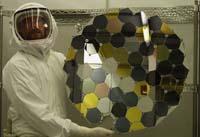Oxygen in the Sun

NASA's Genesis probe took samples of the outer layers of the Sun and took them to Earth for analysis. Unfortunately, the probe suffered an accident in which NASA engineers could not catch the probe when it entered the atmosphere in September 2004 hit the ground surface in the Utah desert in the United States. Since then, astronomers have made many efforts to recover what the probe has brought and analyze the samples that have remained intact. Among those that can be seen in the image, the oxygen in the Sun has been known. They find a surprise: the proportion of the oxygen isotope 16 is higher in the Sun than on Earth.
Oxygen 16 is the most abundant isotope of oxygen, but it is not the only one. Like this, 17 oxygen and 18 oxygen are stable isotopes, but they hardly form, so they are in a very small proportion. On planet Earth, 16 oxygen is about 99.8% of oxygen. Measurements on meteorites, Mars and the Moon yield similar results. But in solar samples the proportion of oxygen 16 is even higher.
Astronomers believe that the Sun's data is the reflection of the original oxygen of the solar system. Whether or not astronomers have begun to work to explain why the distribution of oxygen isotopes is different in the Sun and Earth.





